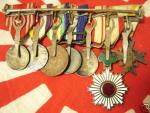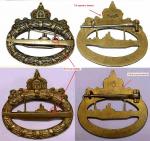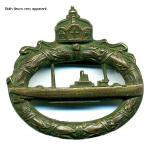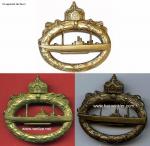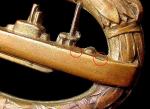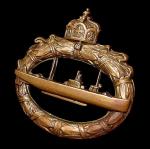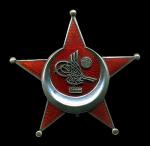
Tim B
Past Contributor-
Posts
2,234 -
Joined
-
Last visited
-
Days Won
2
Content Type
Profiles
Forums
Blogs
Gallery
Events
Store
Everything posted by Tim B
-
First one of this particular style I've seen. Not a lot of information on medal bars in general, or the bar holders themselves, so hard to say what time period this one is actually from. I think this piece is unusual in the fact that you can move the location of the individual medals for placement, though I don't understand why it would be important. I also understand they continue to produce holders today, though I don't know how they compare to period made pieces. As far as attachment goes, pretty much the same as a regular bar, the medal has a "hook" sewn into the top of the ribbon and an "eye" sewn to the reverse and then when placed over the bar, the hook is looped into the eye. I have also seen bars where they sew thread around the medal suspension to aid in holding them in place. Hope that helps answer that part. Tim Here's an example to help show what you're looking at on Japanese bars:
-
Hi guys! Well, this is what I like about forums; actual discussions, and sharing of opinions and information. Can't get that in any book or magazine. Gordon, I do notice the similarities here and have to be careful with two badges of different wear and under different lighting conditions when the PIC's were taken. Really hard to tell sometimes with differences in shadowing, angles, hand finishing, and overall finish coming into play. The noticable differences are of course the trademark Maybauer pin setup and the forward antennae being reversed. I do see the crown similarities but, the cuts, as well as the level of details are slightly different. Perhaps due to different levels of wear or hand finishing, I honestly can't say. I also see very minor differences in the upper laurel leaves that have more curl to the high points of the edges on your example. Again, this could simply be attributed to wear differences between the two badges. Would like to see more examples if possible! I have always loved Maybauer pieces. Do you know if Matt has any hard evidence showing Juncker did in fact get the initial contract for these U-boat badges and if so, were they the only ones? I don't want to seem like I am doubting this information, only want to see what there really is that more or less proves the Schott/Juncker connection. That makes me wonder when the other manufacturers like Meybauer, S&L, and AWS came into the picture for these. Just thinking here: If we use the old supply & demand rules and take into account that the war was pretty much over by the time the badge was instituted and awarded, and a good majority of it's men didn't survive the war, how many badges were actually needed? Would manufacturers gamble on mass producing an item such as this? Seems wasteful IMO. Add to that, Germany was not allowed to keep her boats at the end of the war and it would be several years before she started secretly building boats outside Germany; those members that did survive would have either transferred to other types of duty in the Navy, or got out altogether and went home after the war. With the terrible economic situation faced by all, I find it hard to believe those that got out would pay money for a badge they no longer needed or could wear, when that money could help them survive. I don't know, just trying to figure things out. Tim
-
The other questions I had on the Schott badges centered on the die flaw progression and if anyone has placed any timeline on these? Again, I understand these badges were produced into the 20's & 30's, but not knowing how many were produced and when, the die might indicate approximately "when"; maybe. For years, I thought the indentations on the bow were badges that had got damaged (little dings through wear and tear) but, over time noticed that there was a consistency of where these marks were occuring. Here are a couple close-ups of the die flaws on my badge. Tim
-
Gordon was kind enough to send me a link to a fellow collector's site that studies Juncker produced items: http://www.cejuncker.com/3.html I've contacted this Matt, and he is currently away from the material he has to add further information on the subject. I'm not sure if he is a member here or not, but would like to hear more on the subject. Anyone want to add some information? Tim
-
One of the reasons I ask, is that back in December, 2005 Detlev listed this marked Juncker U-boat with Militarpass and the die characteristics are different from the Schott marked badges. Looking in Detlev's 2nd revision of his price guide, I see another unmarked version on page 33 that matches this Juncker marked piece. So, did Juncker have more than one die or variety of U-boat badge? Seems like they really wouldn't need a second one considering the late date of the award being authorized (1918)and the amount of sailors that had already been killed in action. I honestly don't know and pass to those more knowledgeable at this point. Tim
-
I have wanted a nice Schott marked badge for several years now and just never found the right one or had the money available when one popped. Just recently, I got lucky with this one from Erik Krogh. Many thanks again Erik, it's a real beauty! Hope you found something you really wanted at the SOS! I have been looking at these online now for sometime and have been anxious to start this thread to ask some questions but, wanted to find out a little bit more first. I understand that Schott was simply the designer (sculptor) and designed the U-boat badge when first conceived. He was not a manufacturer or actual producer of items per-se. What surprised me though was the possible Juncker connection to Schott badges. Is there any actual evidence to support this, or is it still educated speculation? Regards, Tim
-
Kriegsmarine Narvik
Tim B replied to nesredep's topic in Germany: Third Reich: Wehrmacht Medals, Decorations & Awards
Nice one Peter! Beautiful condition! Tim -
Hi Demir, No, the balls (finial's) are fine; that's just me playing with my photo-editing skills. The background in the seller's PIC was originally white and the shadows sometimes make it impossible to get it 100% correct without losing stuff. What you're seeing is left-overs of the white background. I just don't like posting dealer/seller site PIC's if I don't have to. I'll look again at the Mahlas, but I thought it was identical, only rotated to a different angle. Thank you for posting! Tim
-
Here is another one that is strikingly similar except the enamel pattern appears to have longer diamond shapes on mahony's and the example I posted when compared to Josef's TWM and the border of the star arms on Josef's TWM are doubled and more like those of BB&Co. Additionally, that little hole is not as round on Josef's example. Other than that, they appear the same. Tim
-
Not sure who the maker is or if it's German or Austrian, but it is marked "silber" on the pin and similar to the one posted by "mahoni" and "Josef" earlier in this thread. If the guys don't mind, I wanted to post a couple quick comparison shots for discussion. Tim Here's the one with "mahoni's" TWM, though I do not have a whole PIC for comparison, it appears the same style: Note the star arms have the narrow silver border and the "hole" in the Tugra is round in design.
-
Well, I thought I got lucky yesterday and picked up a rather nice looking TWM but, was just informed this morning that someone beat me to it. I would like to do a quick comparison of a Star here to seek opinions and knowledge as I continue my database on TWM's. Tim Here's the Star I was hoping to have:
-
Hello Demir, Again, as stated in the new Mahlas thread, many thanks for this information and confirmation that I don't need to worry about the "right-side" up orientation on this feature. Tim :cheers:
-
Demir, Many thanks for that information! I see so many that have this Mahlas rotated in various angles and wondered if it was something the manufacturer didn't really understand when attaching it to the star, or if it was something a collector needed to pay attention to when looking for them. Thanks again! Tim
-
Hello Demir, I have a question concerning the Mahlas. Is it necessarily a bad sign on TWM's if the Mahlas is not oriented exactly correct per the figure you show? Meaning, can the Mahlas be rotated slightly, or does it have to be right-side up as in your figure? Thank you! Tim
-
Hi Graham, Have you searched the other CdG threads in this forum? Tim
-
A New Krim
Tim B replied to Tim B's topic in Germany: Third Reich: State, Civil, NSDAP Awards & Decorations
Hello Andrei, That's my point made earlier; all Krims have similar design traits and some have details "here and there" that closely resemble other maker's shields, but it doesn't tie them together. IMO, this is not related to Orth whatsoever, regardless that there are some minor similarities. When a maker manufactured their items, we see specific die characteristics in that design and seldom see a completely different design altogether. This one is different in many areas. Tim -
Belgium Decoration Militaire Belgium
Tim B replied to g_deploige's topic in Northern European & Baltic States
Hello, Yes, I was watching this one as well, nice score! IMO, you are correct that this is a Type 4 of the Leopold II. I figure closer to 1910 timeframe. I loved the patina on this one but the dented arm tips and money I have out for other items at the moment forced me to leave this one be. Again, very nice! Tim -
A New Krim
Tim B replied to Tim B's topic in Germany: Third Reich: State, Civil, NSDAP Awards & Decorations
Hello Andrei, Assuming the shield you think is a fake "FO" being the one that I started the thread with here; it is my belief and understanding from other collectors that this shield is in fact original, however, I did the comparison to Orth as some had speculated elsewhere that there was an Orth connection, which I did not see or agree with. In my opinion, this zinc shield is original, just not of Orth design or manufacture. I believe it is yet another currently unknown maker. There is an advanced collector that thinks he may have an idea on "who" might have manufactured this version, however he does not want to release that name until more sustantiated evidence is available to link the maker to the shield. So, I have to honor his request to leave that information out for now. Looking at the construction of the shield, backing, and paper, I am confident the shield is 100% original to each part and IMO, an original period shield. Best, Tim


